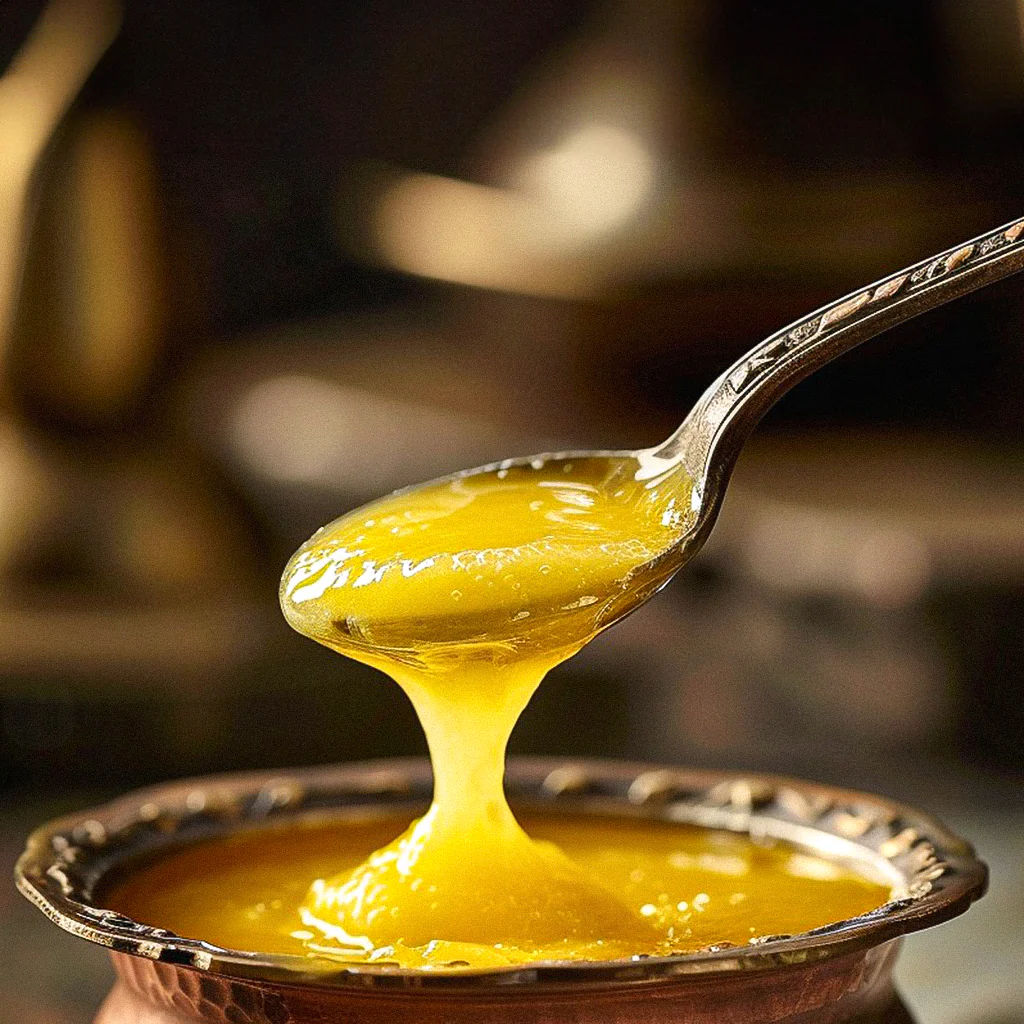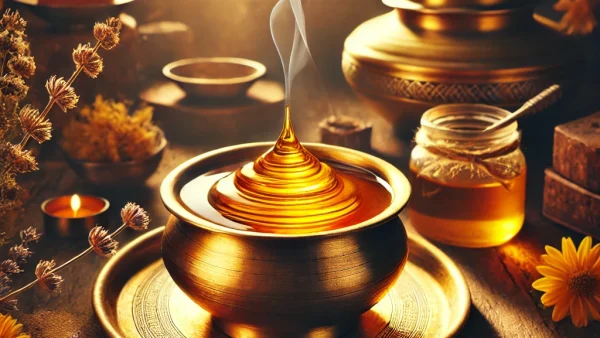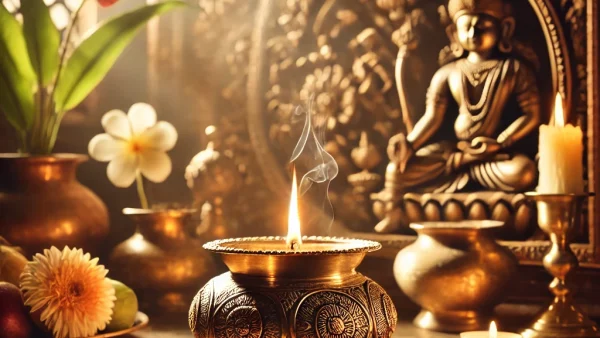Ghee, also known as clarified butter, is a golden, aromatic substance that has captured the hearts and palates of people worldwide, but especially holds a sacred place in Hindu culture and Ayurveda. Revered as a superfood, ritual offering, and symbol of prosperity, ghee is not just a culinary ingredient—it’s a bridge to spiritual wisdom, a healing medium, and a part of cultural heritage. In this guide, we’ll dive deep into the origins, spiritual significance, health benefits, and ways to incorporate this powerful elixir into your daily life.
Table of Contents
- What Is Ghee?
- The Spiritual Significance of Ghee in Hinduism
- The Process of Making Ghee
- Health Benefits of Ghee
- How to Use Ghee in Daily Life
- Choosing Quality: Why Pure Cow Ghee Matters
- Conclusion: The Golden Elixir of Life
What Is Ghee?
Ghee is a form of clarified butter made by gently simmering butter to remove the milk solids and water, leaving behind a pure, golden liquid rich in flavor and nutrients. Originating in ancient India, ghee has a history of over 5,000 years and is intricately woven into the fabric of Hinduism and Ayurvedic medicine. Known as “ghrita” in Sanskrit, it has been cherished as a sacred offering and a potent medicinal substance, with mentions in the Vedas and epics like the Ramayana and Mahabharata.
But why has ghee been revered for so long? The answer lies in its versatility and its alignment with both physical and spiritual wellness. From the Ayurvedic perspective, ghee nourishes all three doshas (the body’s elemental forces) and promotes ojas, the vital essence that sustains life, vitality, and immunity.
The Spiritual Significance of Ghee in Hinduism
In Hinduism, ghee is more than a food—it’s an offering, a sacred element used in religious ceremonies (pujas), and an essential part of rituals. Ghee lamps, known as diyas, are lit during festivals like Diwali to invite prosperity and divine blessings. Ghee is also used in homas (fire rituals) where it is poured into the sacred fire, symbolizing self-purification and the surrender of desires.
Many Hindus believe that burning ghee in a homa carries their prayers to the heavens. In texts such as the Rigveda, ghee is described as “the sacred, purified butter” that sustains the divine fire, symbolizing the flame of knowledge and illumination. This timeless ritual highlights ghee’s role in connecting the earthly and the spiritual, reminding us of the simple, profound act of nourishing our body and soul through nature’s offerings.
Anecdote: The Tradition of Ghee-Lamps
Lighting a ghee-lamp is a common practice in Hindu households, especially during auspicious occasions. Growing up, I remember watching my grandmother carefully pour pure ghee into a small brass lamp. She would place it at the altar each evening, allowing the warmth and radiance to fill the room with a gentle, comforting glow. “This is not just light,” she would say, “it’s our devotion, our love, offered to the divine.” Today, I carry on this tradition, feeling the same warmth, both from the flame and from the sense of connection it brings.
The Process of Making Ghee
Creating ghee is a meditative process that requires patience and attention to detail. Traditionally, ghee is made by boiling unsalted butter, allowing it to simmer until the milk solids settle and the water evaporates. The result is a golden, aromatic liquid that’s full of healthy fats and free from lactose and casein.
Steps to Make Ghee at Home:
- Start with Quality Butter: Use unsalted, grass-fed butter for the best results.
- Simmer on Low Heat: Melt the butter over low heat, letting it simmer. You’ll notice the foam forming on top—this is the water evaporating.
- Strain and Store: Once the milk solids turn golden and settle at the bottom, strain the ghee through a cheesecloth into a clean jar.
The process of making ghee is reminiscent of its Ayurvedic role in nurturing health, as each step requires patience and mindfulness, resulting in a nourishing end product.
Health Benefits of Ghee
Modern science is increasingly validating what Ayurveda has known for centuries—ghee is a powerful ally for health. Packed with fat-soluble vitamins, essential fatty acids, and antioxidants, ghee has numerous benefits for the body and mind.
1. Supports Digestion
Ghee is a rich source of butyrate, a short-chain fatty acid known to improve gut health. Butyrate helps nourish the cells of the intestine, making it easier for the body to absorb nutrients. In Ayurveda, ghee is thought to ignite Agni (digestive fire), promoting efficient digestion and assimilation of nutrients.
2. Boosts Immunity
Ghee is believed to increase ojas, which is considered the essence of immunity and vitality in Ayurveda. With its high concentration of antioxidants, ghee helps to boost the immune system, keeping the body resilient against infections.
3. Promotes Heart Health
Though high in fat, the specific fats in ghee—particularly monounsaturated and saturated fats—can support heart health by balancing cholesterol levels. Ghee also contains conjugated linoleic acid (CLA), which studies show may lower cholesterol and reduce the risk of heart disease.
4. Enhances Brain Function
Ghee is a natural source of healthy fats, particularly omega-3 and omega-9 fatty acids, which support cognitive function and memory. In Ayurveda, ghee is said to nourish the mind, helping with concentration and mental clarity.
5. Skin and Hair Health
Due to its moisturizing properties, ghee is widely used in Ayurvedic skincare and hair care. Rich in Vitamin E and essential fatty acids, ghee can hydrate the skin, reduce inflammation, and improve hair texture when applied externally.
How to Use Ghee in Daily Life
Ghee can be incorporated into your diet in various delicious ways. In India, it’s traditionally drizzled over rice or mixed with lentils. Here are a few suggestions:
- As a Cooking Oil: Ghee’s high smoke point makes it ideal for sautéing and frying, preserving the nutrients in your food.
- In Beverages: Try adding a spoonful of ghee to your coffee or tea for a creamy, nutritious twist.
- In Ayurveda: Mix a teaspoon of ghee with warm milk before bed to promote sound sleep and aid digestion.
Why Pure Cow Ghee Matters
Not all ghee is created equal. The quality of the ghee depends on the source and purity of the butter used. For the full spiritual and health benefits, it’s essential to choose pure cow ghee, preferably from grass-fed cows. In Ayurveda, cow ghee is considered superior due to its medicinal properties and ability to balance the Tridoshas (Vata, Pitta, and Kapha).
At spiritualguru.lk, we offer pure cow ghee crafted to retain its natural essence and nutrient profile. Our ghee is sourced with care to ensure it meets the highest standards, making it an ideal choice for both culinary and spiritual uses.
Conclusion: The Golden Elixir of Life
Ghee, with its deep roots in Hindu spirituality and Ayurveda, is far more than a simple cooking ingredient. It’s a symbol of health, prosperity, and devotion. In a world constantly on the move, ghee reminds us to slow down, connect with nature, and nourish ourselves with intention. Whether you’re incorporating ghee into your diet, using it in a ritual, or applying it as a natural skincare remedy, you’re engaging with a practice that has endured for thousands of years.
To experience the purity and power of authentic ghee, consider purchasing our pure cow ghee at spiritualguru.lk. Embrace this golden elixir as part of your life’s journey towards health, wellness, and spiritual connection.
With this timeless substance, may you find warmth, nourishment, and a little bit of magic in every drop.




Pingback: Types of Ghee: A Spiritual and Culinary Exploration - Spiritual Guru